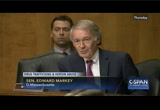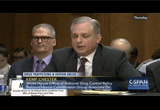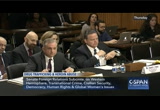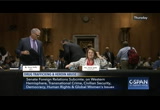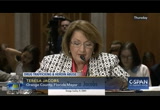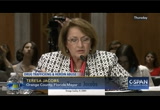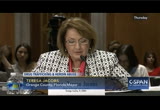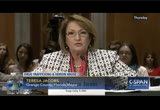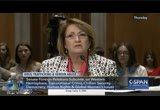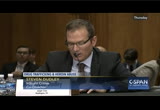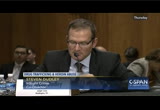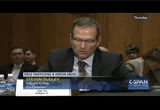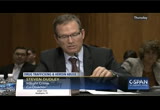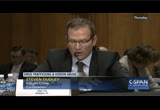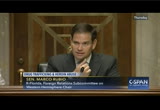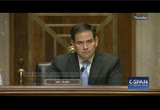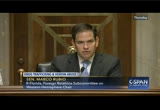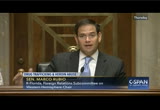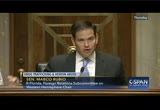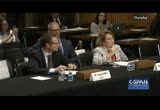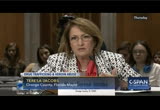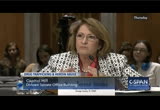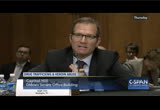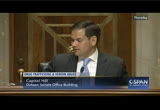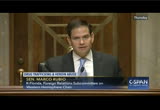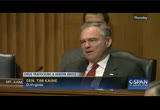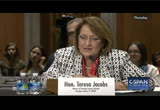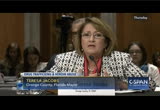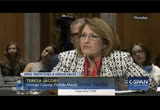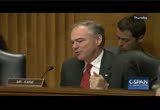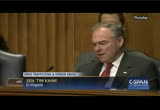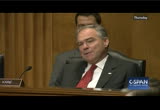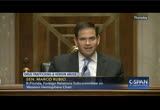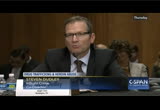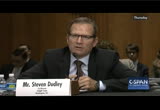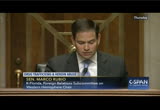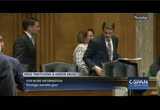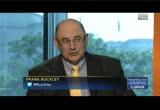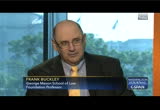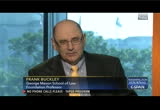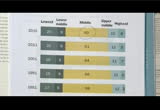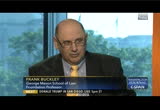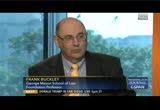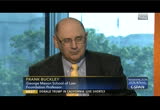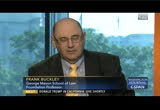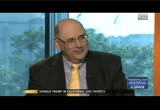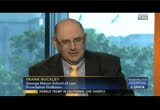tv Key Capitol Hill Hearings CSPAN May 27, 2016 4:00pm-5:01pm EDT
4:00 pm
4:01 pm
.s opposed to heroin again, from my perspective, this is the issue and dwarfs any terrorist threat to the united states. this is what is going to kill people, ultimately hundreds of thousands of americans. this,her frontline on mexico just heard about it. i'm not sure the chinese understand the priority that we expect them to deal with the issue. earlier inhester your testimony today, you said there are gaps in the introduction of fentanyl coming into the united states. could you explain what those gaps are? mr. chester: we were speaking about and our ability to detect
4:02 pm
fentanyl at borders. we brought up the idea of canines being able to detect fentanyl because it is so deadly. gaps,k to address those theetter detect fentanyl at southwest border and in our airfreight locations in the united states. that has been an area of ongoing discussion for us so that we can better determine how much fentanyl is getting into the country and detect it when it does arrive. and whether they are detecting the chemical itself or with the ant which with it is mixed. if i may conclude.
4:03 pm
i would strongly recommend to the administration that when the president meets with the presidents of canada and mexico that he raise fentanyl to the highest level with them and is thehem know that that threat to our country, and the same thing is true in any communications with the chinese government. it has to be at the highest level. >> it is an important issue in the northeast in the country, and we will welcome our next panel. we keep the record open for a few days. if you receive any questions and writing, if you could respond as quickly as possible so we can close the record, but we thank you both for being here. l reintroduced the members of our second panel. whichjacobs of florida, will be the site of the pro bowl . maybe you can give us an update on that.
4:04 pm
mr. stephen dudley, codirector of insight crime. mayor, if you're ready for your testimony, we look forward to hearing you as well. thank you for being here. you chairman rubio and for calling this very important hearing and allowing me to share a local perspective. the conversation has been informative for me and everyone here. a little background on orange to the city of orlando and other municipalities , a strong economy and exceptional quality of life, a population of 1.2 million people, but we also have 66 million visitors on an annual basis and continue to shatter records for terrorism. -- for tourism.
4:05 pm
we are also seeing heroin overdoses and related death. opiates, ands, fentanyl. we lost 62 lives to fentanyl. we have heard about the increase 2007.ths from an orange county, a 600% increase since 2011 alone. we have had 90 reported opioid overdoses, one in 10 resulting in death. s. this wave ofinst addiction began five years ago. florida practitioners were at levelsg oxycodone that exceeded all the other states and our nation combined.
4:06 pm
at a state and local level, we responded. today, the battlefront has moved. today, we fight heroin. today, we fight fentanyl. given the dramatic rise of heroin and fentanyl, one can that drug cartels perceive us as a writer marketplace. it is impossible to assess the , butof the heroin threat there are some things we do know. in orange county, 2000 heroin users move through our county jail alone. given day, we'd treat roughly 200 and one attics in our jail. our county jail held 100 expectant mothers who were addicted, whose babies will most certainly be born tragically addicted to heroin. we know that over 60% of overdose patients are uninsured, and yet we have only one
4:07 pm
inpatient facility with 26 beds forlable to the uninsured all four counties with a combined population of 2.5 million people. our county jail has become the treatment center of last resort for people who find themselves addicted. for the good of our citizens, we are writing back. here's how. last summer we convened a task force. our joint work is having a positive impact, including the 2016 florida legislature passing a measure that will not allow sales without a prescription. no singlee is solution, we know there are some universally effective fo addresses, but we must the demand side while we attacked the supply side. the demand side, throughout our task force, we have joined
4:08 pm
forces with our public education system, universities, faith-based communities, medical communities. we are launching a social media campaign to educate the public on this highly addictive and deadly drug. we are trying to warn our citizens in advance that this is something they want to avoid at all costs. we are not only treating heroin attics in jail, we are implementing a new treatment program. for all of ouron addicts who are leaving our jail. we need the federal government's help to treat more attics. we are woefully short on beds and other resources. doing supply side, we are our best to arrest traffickers on our streets. no matter how highly leverage and coordinated, we are no match for the drug cartel. that is why we need your help to help stop the influx of drugs
4:09 pm
across our borders. the crisis, save lives, and save communities, we china rolled a play. local governments have a crucial role, the state government does and the federal government does, but efforts need to expand beyond government. we need every citizen, a mother or father or friend of an addict, we need our entire communities engaged. we need doctors. we need the clergy. we need counselors. we need teachers. form.d them to all be in that's why we need a nationwide awareness campaign. we have talked briefly about fentanyl. it needs to end cleared the high cost and low cost. it is less expensive for many of our addicts to get high on opioids than it is for them to go and get a happy meal. that is a sad state of reality. it has to be addressed. thank you again for this opportunity. mr. chairman, thank you for you and your committee's continued
4:10 pm
leadership on this issue. sen. rubio: mr. dudley, thank you for being here and your testimony. the u.s. heroin small by quite comparison, but outsize in terms of potential earnings. the u.s. consumers spent as much as $27 billion on heroin each year, an increase from $20 billion in 2000. mexican, guatemala, and colombian criminal organizations have reacted by producing more heroin. accounts forico the bulk of the poppy production in the region. of heroin also indicates that mexican criminal
4:11 pm
groups are moving increasing amounts of heroin into the u.s. market. they are also the key transporters of columbia heroin to the united states. inside the u.s., the trend appears to be the same. the da says that mexican groups are seeking an increasing amount of market share. they are displacing other wholesalers. recently picture of an lucrative, vertically integrated market with mexican criminal organizations managing the product and point of production, point-of-sale, and seeking greater market share for the sales. complexity is much more . it helps to use well-worn monikers, but the truth is they are not a strong and monolithic as they once were.
4:12 pm
the names may still evoke fear and all, but they are not as much organizations as brand names. individual parts have as much contact with the bosses as a local coca-cola bottling plant manager might have with headquarters. case in chicago. before the two brothers were arrested, they were seen to be distributors in chicago, one of the areas of greatest interest to the subcommittee, but they were. federal intercepts of their conversations with cartel leaders of the brothers ,egotiated independently th obtaining different prices for the product they were selling. even after a war started between one cartel and a rival group, the brothers continue to purchase drugs from both
4:13 pm
organizations. the case cuts at two different myths. number one, that this is one single organization. a number two, that it is tightly controlled by a single leader or group of leaders. as shipments get further and further from mexico's wholesale points, the loyalties become dispersed and in some cases completely disappear. the u.s. market, where violence is not a viable long-term option to ensure loyalty, market share, or to become a monopoly. the effectiveness of u.s. law enforcement has made it violence terrible for business and made the distribution system more democratic. while the amount of seizures indicate more heroin is available, it is still moved in small quantities. the median seizure of the dea in .014 was a single kilogram in denver, a 10-12 pound
4:14 pm
shipment is considered large. laredo brothers recently indicted in the eastern district of pennsylvania is indicative of these trends. the laredo brothers are charged with moving one ton of heroin over a six-year time span, 14 kilos per month. the organization was so subtle that the mexican authorities were not even aware of the group. this brings us to mexico. excuse me, the horizontal nature of the distribution chain makes it a difficult law enforcement problem in mexico as well. noted, the ones monolithic criminal organizations are shells of what they once were. the is due to infighting of type mentioned other, but also mexican law enforcement efforts. many of the fragmented pieces of form their own organizations or brand names. the market is broken into numerous pieces, small
4:15 pm
producers, processors, wholesale purchasers, and the transporters. production, transport, and distribution may all be different organizations. laredo brothers, for example, were purchasing opium gum from an independent broker and processing it themselves and distribute it in those small quantities in the u.s. for years without running into trouble with the large supposedly all controlling sinaloa cartel. to be sure violence is still a viable option in mexico, so the pendulum may swing back to more monolithic criminal organizations, but there are now literally dozens of small criminal organizations involved from the point of production to the point-of-sale. while the level of control the groups exert over the supply chain is clear, we are not talking about one or two criminal groups, but dozens of interlocking organizations whose alliances are constantly
4:16 pm
shifting. chain appearsply to be a largely horizontal, diversified operation with multiple actors, at one minute obedient to market forces rather than one or two vertically integrated distributors. the result is that law enforcement efforts ar largely muted. you are entering a small part of the overall production and distribution chain. if you did slow the heroin from mexico, you would face an insurmountable task stopping the flow from other countries that will fill the void and count for the bulk of worldwide production anyway. canada are ready gets 90% of its heroin from afghanistan. time and for your attention. i look for to your questions. sen. rubio: thank you both for being here. i want to begin with one of the questions i alluded to in the testimony.
4:17 pm
i guess it is a bit anecdotal because we don't have a number behind us. that these criminal groups are specifically .argeting people recovering in essence, they stationed themselves outside a rehabilitation outpatient center knowing that these people are vulnerable and enticing them to fall back into addiction. mayor, have you seen evidence of this. mr. dudley, have you heard about this as a recurring issue, a specific practice at the local level of targeting people in recovery for sales? ms. jacobs: i have not seen evidence of targeting our treatment facilities. that it certainly appears on the surface that there has been a targeting which communities
4:18 pm
to infiltrate with heroin. i look to the increase of heroin coming into our communities, the increase of fentanyl, at the same time we were restricting access to prescription drugs, suspecting there is a strong correlation between those two and causation as well. mr. dudley: we don't have direct evidence of this activity on a local level. i will say that mexico criminal groups have targeted recovery facilities, but more as recruitment centers. toruitment centers for them, build up their own criminal operations. you mean for like dealers? dealers, butot for
4:19 pm
for memberships, people who participate in criminal organizations. that has certainly happens. ed. the upshot of this is to say whether or not they are targeting, pushing drugs in ittain areas, i'm not sure is as relevant as this whole picture, which is what the mayor alluded to, that this is largely driven from former people who used pharmaceutical drugs, and those people you can find all over. the dispersedfor nature of this epidemic as opposed to the 1970's, where you had a very concentrated in urban areas. now we have it spread out through many different parts of the united states. sen. rubio: i have a personal friend who is a police officer in miami-dade county. he recounted a story when he pulled up to a car on the side
4:20 pm
of the road and there was a woman in the driver seat slumped over, and caught his curiosity so he pulled over and knocked on the window. it was a nice car, personal financial means. knocks on the window, and the person immediately pops to attention, and he can see that in her arm there is a needle. she was basically shooting up on the side of the road in a luxury vehicle. knocks on the window, she rolls down the window, they begin to interact. obviously he has a decision to make about how to treat her. he said this is someone that he would have arrested her and taken her in 10 years ago. today, his perception has changed because of several interactions, including this interaction. a member of the florida bar, a successful, functional attorney, has ahusband also problem. he does not view her as a criminal. he views her as someone who has
4:21 pm
a disease and its treatment to overcome it. her gait way was a use of a pharmaceutical painkiller for a surgical procedure. she lost access to the medicine, and this is what happened. dependent upone an opiate substance, irrespective of how you got there, but let's say in the case of this person because of the use of a pharmaceutical that led to this point, there is still in next ordinary stigma associated with it. you are doing a really bad thing and it needs to be punished. second, even if that stigma were to change, excepting the fact that i am physically dependent on the substance, in many communities there is nowhere take them. the only place you can take them is to jail, where you hope their withdrawals are managed, but may not be. many places don't have the
4:22 pm
capacity to meet that reality, which leads to the third problem, the number of people who end up in the jail cell for 15 days, go through with a drawl, do not realize that they have lost her tolerance, and when they fall off the proverbial wagon, they go back to using the levels they were using before they went through withdrawal and it kills them because they lost their tolerance for an opiate. i'm suret perspective, there are hundreds if not thousands of cases like that. what are the impediments of getting someone who could be watching c-span at this very watching this are hearing us talk about this, what is out there today, what is missing for someone who needs this treatment and does not know what to do about it? especially for the uninsured, there are not many options. thank you mr. chairman. that is a key part of addressing the demand side. part of it is to educate people
4:23 pm
and help them make the right choices to avoid overuse of perception drugs. the other part is how do we provide the resources to treat people who are addicted. the treatment options are very limited. for the uninsured, 26 beds for 2.4 million people. jail, one out of four in the on averagehele have 200 people. we need more treatment facilities. ,hen you asked me the question are dealers preying on people coming out of treatment centers? the reality is we don't have enough treatment centers to prey on. you said that you believe that florida was specifically targeted because they knew we had the pill mill problem, and once that was cut off, these folks were going to need. ms. jacobs: that's what i believe. i don't have the empirical
4:24 pm
evidence. i have evidence of the increase in flow of heroin and related deaths. that is in correlation to cutting off our pill mills. more we were dispensing oxycodone than the rest of the country combined at a florida, most of that was leaving our state, and most of these pill mills, you could drive up and look in the parking lots. the parking lots would be full, and only a percentage of those were local license plates. the cartels may have misjudged the appetite, but they no question have flooded us with very cheap drugs, and the number that i have seen who are struggling with addiction and have turned the corner and been able, have had the good fortune and money to find treatment, the insured portion of the population, to see that there is actually life after heroin addiction is very encouraging, but what is very
4:25 pm
discouraging is that most people who are addicts have no idea there is life, and most people who are addicts have no opportunity to get to those treatment centers. sen. rubio: we had these facilities. my necked up and said hurts, my back hurts, and by routine they would give you a package of prescriptions. people knew this, and you would have busloads come in sometimes. the florida legislature close that loophole that was allowing this to happen. were not talking about the prescription being written by a doctor. it was these specific facilities that drove it. did you want to add something on the treatment part of it? mr. dudley: this is obviously framed as that law enforcement debate. as you rightly pointed out, this is a public health issue. it, this is af pharmaceutically driven epidemic and health issue.
4:26 pm
that is the difficulty in facing up to this. it isn't necessarily a strictly law enforcement -- were not talking about throwing people in jails. we need to be talking about how to get them better treatment. sen. rubio: i don't believe anyone wakes up in the morning and says today is the day of become a heroin addict or an opiate addict. this is not something people want to happen. people don't realize the power of this. there is no responsible way to use this. we know that some people are or susceptible, but it basically restructures the brain's chemistry and away a disease would. it has to be treated like that. has 83 heroin deaths in 2014, significantly -- other communities have large numbers, miami at 60, sarasota 55, but that number pops out at you as a
4:27 pm
place that has been specifically targeted, and then you see the rise and deaths and the spike we have seen across the country in heroin and opiate deaths, where the takeoff point has been hi is the introduction of fentanyl, and incredibly powerful and lethal substance which is not prescribed outside of a hospital setting to begin with on the pharmaceutical side and is now being laced -- and i want to go to senator kaine, so i wanted to leave with this thought. i read a report were someone who was a former and now recovering addict was asked about this and said, when you hear that someone has died from an overdose that was sold by a particular dealer, uy fromes you want to bu that particular dealer because you know what they are selling is the strong stuff. edges just kind of tell you the point we have reached here where
4:28 pm
it is a difficult and debilitating condition that we have to try to understand here, and one of the keys is to remove the stigma associated with it, and i think many of us would be very surprised that the number a people we interact with on daily basis have a dependency problem, maybe not street heroin , but some sort of what we have seen happen in this country and hopefully we can make advances in pharmaceuticals of that we can draw the line and be able to treat pain effectively in this country without putting people at risk. sen. kane: if the demand for drugs is so potent and has hooks and people so deeply, we have a
4:29 pm
really tough problem in richmond and a lot of drug-related homicides were taking place in this neighborhood near where the church i go to is. the number of stories that would appear on the front page of the paper about somebody from the suburbs to come in and buy drugs and get shot, you would think after the stories, people would not drive in, but they kept driving in to buy drugs. that is just evidence of how powerful addiction is. the need is so intense that i'm still going to go. it sounds like you have seen that in your community. it's the same thing of this addiction, and that's why the treatment issues are so important. the other thing we used to hear not inexpert in this field, but when somebody is under the grip of addiction says i want treatment, that is a
4:30 pm
window that opens where the treatment, if it's not there, the window could close. and when the bed opens up, the be past the point of wanting treatment. i'm curious if you could talk the way tomayor solve some of these challenges is definitely through having partnerships, state, federal. talk about what you have done in your county on the partnership side. have the right stakeholders around the table? are there things we can do at the federal level to ensure that if we are issuing funds, we do maximizesy that multilevel stakeholder cooperation. red is often orlando. fred is on here.
4:31 pm
think one thing we have done effectively is regional cooperation and collaboration, and i think that is crucial on tacking any large issues such as this. one of the reasons we pulled together the task force we did was that we brought in so many different disciplines to make sure we could attack this problem from all angles. -- weould suggest that as have limited resources at all government levels. it always seems like the demand for resources outpaces supply, so it is important that programs are structured in a way that the funding is put to its best use. i think that collaborative effort is important. we have the metropolitan bureau of investigation that pulls resources,fferent that has been very effective for us on the enforcement side of
4:32 pm
this. aboutms of your comments that window of opportunity for addicts, i can't understand it either. experienced a feeling of needing something so badly that i'm willing to risk my life to have it. i do understand that is the reality. once we formed the task force, enough people came forward, literally walked up to me on the street, you know what it's like to be a local mayor, people recognize you, come up, and pour their heart and soul out to you. it is a blessing to be at that level where you can hear firsthand. i have seen young people that you would never in your wildest imagination would think our heroin addicts tell me their stories. i also saw the other side. i saw they came out the other side of heroin addiction and are living full lives, getting
4:33 pm
college degrees, and they will be productive members of society. i think that most heroin addicts do not believe that is a possibility. moment, 15e that minutes, two hours, two days, where they say i want to kick this, the reality is they will not be waiting for two weeks or a month. they will be waiting a lot longer in most of our communities to get into a treatment facility unless they have a substantial amount of money, and that is a huge problem. as i said in my testimony, the best option is our county jail right now. that is a lousy option. jail, say we have a bad but having a record does not help the situation. to have options available. we need to have education. we need to have hope. we need to have communities engage. destroying more than lives. it is destroying entire communities.
4:34 pm
we had a chart recently placed before us sen. kane: we recently had a chart of ods per capita. if you look at a chart that is about up problem, crime, or social breakdown, high income states will be in one part and low income states in the other part. if you look at the top 10 most affected states, they included the poorest and richest states in the country. if you look at the bottom 10 affected states, they include some of the poorest and richest states in the country. similarreally like any epidemic or law enforcement problem i have ever seen. that tradition demographic is not a predictor. is suburban, all regions. i went to a drug court , a founding drug
4:35 pm
court in virginia, and the judge who founded it, who was the super farsighted thinker about the need for drug courts, had a child many years later who was killed in a drug-related incident. after i spoke at the graduation, one of the probation officers who helps the court run and is a spectacular advocate said this is my second graduation this week. i went to my son's graduation in a community about two hours from here. , andaffects every level that is why we are now spending the time that we are. hisave not spent time in committee on it, and it's really important we do so. this is not a problem that even has national borders. we have to grab a hold of some of the dimensions, mexico, china, the other nations experiencing this, and build those partnerships, not even in
4:36 pm
a metropolitan region, but law enforcement another partnerships internationally. thank you for your testimony. sen. rubio: these transnational groups targeting us, you talked about this, so i wanted to reiterate it. beingr it is fentanyl produced synthetically or poppy-based opiates being grown in the western hemisphere, and a ticket or mexico, they are coming here. this is the almost exclusive market for these trafficking networks, is that correct? mr. dudley: that is correct, absolutely. there is a small market, global market, that they can satisfy, but it is minimal. would think so logically they are crossing the border and you would think that the easiest from a logistical point of view is for them to flooded into texas or california or a border state, but you are
4:37 pm
hearing where the outbreaks are, and this is a national problem. there is no community that does not face it at some level. you see these outbreaks in the northeast, massachusetts, florida -- how is it winding up in these pockets? what of the distinguishing characteristics? view is the distinguishing characteristics that turn a community into a high propensity, high-risk area? it is such a new phenomenon because it is so dispersed. dispersedhat it is so is really what leads to the criminal organizations being so dispersed, and the notion that we have one single all-encompassing enemy called the sinaloa cartel and once we
4:38 pm
incarcerate chapo guzmán, then everything will be resolved, it is simply not correct. because of the dispersed nature of the market and the way in which these criminal organizations will satisfy that market. it is a not thing, because in a way it -- there are certain thatnts of this epidemic we are victims of our own success. the fact that you would create ways so that you can't tamper with oxycontin, for example. you can't snort it anymore. the way in which it is distributed, well, that makes it less available to people and they start to search out other things. the way the mexican government in conjunction with the united capturedvernment have or killed several of the larger leaders of the criminal to aizations has led fragmentation of these groups, responsiblegroups
4:39 pm
, this is a group that was an offshoot of a larger group, and there are several like them. to wrap your hands around this as a law enforcement issue, it is incredibly difficult because the terrain is so much more horizontal than vertical. even when you take out the larger leaders, what you are left with is a fragmented aiminal landscape, and landscape that does not necessarily as the cocaine market that might depend on getting product from another country like they do from the andes region, they need to get their product from other criminal organizations, but they don't have the dependency when it comes to the poppy production, which is local, and the heroin production, which is local, so they can produce all of this themselves, which makes
4:40 pm
it much more difficult to wrap your hands around as well. sen. rubio: i want to thank both of you for being here and sitting through the previous testimony. i hope that was insightful as you continue your work. i want to thank you for coming here today and being a part of this hearing. this is an important issue. there has been a lot of debate about what is being done domestically, but this has to be dealt with. it has to be dealt with comprehensively, whether it is on the treatment site for people to recover, on the prevention side, but also by targeting these organizations who are in the business of murder, basically, which is what this ultimately is. the direct murder of americans by targeting us with the distribution of these products in our country, so i want to thank all of you for being here. i also want to ask consent to enter a statement for the record of jack riley, the acting deputy administrator of the dea.
4:41 pm
for this hearing is going to remain open until the close of business on tuesday, may 31. you might receive some questions in writing. if possible, i ask you to respond so we can close the record on this. thank you both for being here. this meeting is adjourned. [captioning performed by the national captioning institute, which is responsible for its caption content and accuracy. visit ncicap.org] [captions copyright national cable satellite corp. 2016]
4:43 pm
♪ and thursday,y june 1 and second, c-span's washington journal will be live in laredo, texas to talk about immigration and trade issues. on wednesday, we look at immigration with the managing editor for breitbart texas. illegal about immigration, the players, and efforts to cover the security and humanitarian aspects. lawyer will talk
4:44 pm
about practicing immigration law in the area. who she represents and the laws on the book related to citizenship and deportation. we examine the cartels and mexico, including the violence and smuggling of humans and narcotics. he is the author of the book midnight in mexico, reporters journey through mexico's dissent into darkness. a trade reporter with the san antonio express will discuss the flow and blame a trade across laredo border. a congressman from texas will join us to talk about how trade benefits laredo and the country. bob quast, state director for the fair trade coalition and nafta critic, looks at how the trade deal took jobs from southern texas to mexico and how it hurts mexicans as well. be sure to watch c-span's washington journal beginning live at 7:00 a.m. wednesday and thursday, june first and second, from laredo, texas. join the discussion.
4:45 pm
were going live to a donald trump rally in san diego. the san diego union tribune writing that supporters and protesters are on downtown streets. most of the crowds or near the convention center where donald trump is scheduled to speak. the story says a few anti-trump protesters were gathered near the convention center in their designated fenced areas known as free speech zones. the warm up for donald trump, sarah palin, began speaking within the last hour. we are now learning that donald trump will not debate bernie sanders before california's primary on june 7. part of a press release from donald trump's campaign reads "based on the facts that the democratic nominating process is totally rigged and crooked every clinton and deborah wasserman schultz will not allow bernie sanders to win, and now that i
4:46 pm
am the presumptive republican nominee, it seems inappropriate that i would debate the second-place finisher." we will have coverage of the donald trump rally in san diego, california scheduled to get underway in 15 minutes from now at five a car eastern time here on c-span. in the meantime, look at whether americans are able to make economic progress. frank buckley, what is the premise of your book? of america"? guest: we have changed as a country. we were the country of that, wherever you came from, you had the chance to rise. now it seems that is broken. now we are not that country. , theu look at the numbers way a lot of people cut them, that country is denmark or maybe canada.
4:47 pm
that is shocking. i think that helps explain what is happening in politics today. host: when you talk about mobility, what do you mean? correlation between the earnings of parents and children. that is how this is measured. immobile.y we are like england in that respect. we are not as we imagine ourselves to be. the kind of country where you can get ahead. that is deeply disturbing. pollsters tell us most americans think their kids will not have it as well off as they did, for the first time. that is revolutionary. marx had a problem with america. americast theory, should be the first company to go communist, because the stages were agrarian, capitalist, communist.
4:48 pm
america was capitalist. it was not happening. reason that is happening is that class was very mobile. but now we are in mobile. we have their credit parents who raise mericratic kids. to 10% stock at that level. that is disturbing to a lot of americans. ist: the theme of your book inequality. "the level of income inequality at anys higher than point in the last 90 years. there is even less mobility in america than in most first world countries. that is new and it will transform american politics." that "theto write tragedy of america is that while the left often asks the right questions, it almost as often
4:49 pm
provides the wrong answers. income inequality is no exception." up on i am here to beat both political parties. -- thet has dismissed right has dismissed concerns about income inequality. they say does not exist. i think it is there. it is all about envy, and we do not like envy, or that it is about a move to a high-tech economy and we cannot do anything about that. i say fiddlesticks. they are not living in the stone age in denmark. we do not think we are mobile. bad is transformative -- that is transformative of our politics. if you look at the causes for this -- the left realizes this is a problem.
4:50 pm
but when you look at the causes of immobility and you compare this country to other countries that are more mobile, you see k-12rences in respect to education, to immigration, to the rule of law. in those cases, we are talking about programs the left really likes but that cause immobility. it,he right does not get but the left gets it and does not give the right answers. frank buckley is our guest, wrote "the way back: restoring the promise of america." 202 is the area code. 748-8000 for democrats. 748-8001 for republicans. 748-8002 for independents.
4:51 pm
i think you got the idea of what we are talking about. "phony nation," the 1% movement of 2011 argued that gains to the wealthiest off of theame poorest americans in a zero-sum society. in other words, one more dollars for the rich means one less dollar for the poor. some politicians would have you think that is the way it always works, but there is a finite amount of money in the world that song again and others lose. in that case, we never see economic progress. guest: i cannot have said it better myself. host: can you expand on that? further, i said we are not in a zero-sum gain. what interested me was the negative sum game, where we have barriers to registry and
4:52 pm
licensing requirements. all of those things which keep people from getting into the labor force are getting into the labor force. that is wasteful. here we are, in your studio, looking at the capitol there. behind it is k street, the biggest amount of patronage seen in any country at any time. that is part of the problem as well. a good part of the way back is trying to blow up those kinds of networks and freeing things for people who want to rise, as they did formerly. ew came out with a study about the middle class. it says the middle class is shrink and. 61% of people lived in the middle class in 1971. it is down to 50%. the real growth is on the highest level. others have stayed steady. is this a bad thing? it is not bad when people
4:53 pm
move into the upper class. but on average, we have a fairly threatened middle class. a middle class that is not rising as it should and seems to be less wealthy than the middle-class and other countries. that is something i think most americans get. you can slice this up in a variety of different ways, but overall, i was shocked to look at the differences between mobility here and mobility in other countries. that interested me most is the country we most closely resemble, and the country from which i came -- canada. what i found shocking was the way in which if you are in the top 10% here, the chances your kid will be in the top 10% or 20% are about 50%. you will stay there. if you are in the top -- the
4:54 pm
bottom 10%, the chances your kid 10% of in the bottom 20%. in canada, you have it good shot a moving up and if you're the top, you have a shot at moving down. it is not that way in this country. it is because the game is stacked in favor of aristocracy. i want to argue there is nothing surprising about that. that aristocracy is the natural default of any society. we like to think if we relax, everything will be cool and we will move back to being a highly mobile society. i say no. if you look at the history of the world, it is the case that aristocracy is the way it has been pretty much all the time. you get reach interludes of great mobility. then we seem to revert to a kind of aristocracy. so you get high mobility after
4:55 pm
great events like a war, like the revolutionary war or the is a war, or whether there great transmission in the economy. but then we seem to settle back into a society stick -- thick with rules and influence. those gone the way of people moving. obamar you feel about care, there is one statistic people find shocking. it was a 1000 page bill crammed with a lot of goodies -- by the way, the medicare bill in canada is 12 pages long, and it is bilingual. so 1000 pages long. but the regulations are 20,000 pages. try to work your way around that, if you are a health care professional. it is crazy. so we have a plethora of rules. this is wonderful if you are an established business. but if you are a small guy trying to move up, it is terrible. it is a wonderful society if you are surrounded by lawyers.
4:56 pm
young guy ore a entrepreneur just starting out and you do not have the connections, it is not so good. that is the kind of thing i am talking about. host: you talked about the aristocracy in the states. what is canada doing right in your view? guest: one example in the news is immigration. there was a story recently about how the new prime minister of canada welcomed syrian refugees. , will takethe end around 50,000 syrian refugees. many will be christian, by the way. that is something of which someone can be proud, as a canadian. by comparison, the american number seems to be about 5000. if it matched canada, it would not be 5000 but 500,000. moreover, it was america that, more than any other country, caused the problem by a crazy war in iraq. it was like a child in an
4:57 pm
antique store it that broke something and then walked away from it. in other respects, canada has an immigration system donald trump would love. canada puts illegals on the plane. and has an immigration system geared toward providing jobs to canadians. the me tell you something that i find interesting. canada is 20% foreign-born. none of this is a political issue in canada. it has way more immigrants, but it is not it medical issue. why -- everyone realizes it is good for the country and good for us. here, we have a sense this is bad for us. thepeople most hurt in united states are african-americans. they have -- they would have the jobs that are being competed away by illegals or by family preferences. so the american immigration system is crazy.
4:58 pm
just a confession of failure. it is based on something which does not make sense -- a family preference system. when people came over from the old country, the old sod back in -- now we have something like cell phones and cheap air for. it is easy to get back -- holland or ireland or wherever. the argument for family preference is not there. there is an argument for economic migrants. a countrye numbers, 1/10 the size of the united states takes in more economic migrants. 160 thousand in canada, 140,000 here. ais is not a way to run railroad. it is why it is such a political hot potato. that is just one example. host: what you think of the term
4:59 pm
"populism." not have a good feeling about populism, but i am beginning to think i am a populist. it is conflicting. it is a good way to construct your loss on how to make americans better. now, the republican party seems to be torn between purists on one side and populists on the other. my view is the republican party was not blown up by donald trump. rather by mick barney -- mitt speech when he gave his about the foursome percent of takers. he gave his 59 point plan which no one remembers. but we remembered the 47%. there isthe idea that "us" and "them." tocommunicated a commitment sensible combine with a disaffirmance -- a this interest
5:00 pm
towards people. isinterest towards people. trump, there is a sense he is on your side. that is populist. way of he will have a swinging it to bring everyone together. i want to argue it would be good , and,e more mobility indeed, equality would follow. i call that socialist ends. the difference between the party is that trump's party once that wantnts that and the dems that. there are two ways to get there. one is by socialism and the other is by capitalism. we should get rid of the things preventing people. host:
30 Views
IN COLLECTIONS
CSPAN Television Archive
Television Archive  The Chin Grimes TV News Archive
The Chin Grimes TV News Archive  Television Archive News Search Service
Television Archive News Search Service 
Uploaded by TV Archive on

 Live Music Archive
Live Music Archive Librivox Free Audio
Librivox Free Audio Metropolitan Museum
Metropolitan Museum Cleveland Museum of Art
Cleveland Museum of Art Internet Arcade
Internet Arcade Console Living Room
Console Living Room Books to Borrow
Books to Borrow Open Library
Open Library TV News
TV News Understanding 9/11
Understanding 9/11
